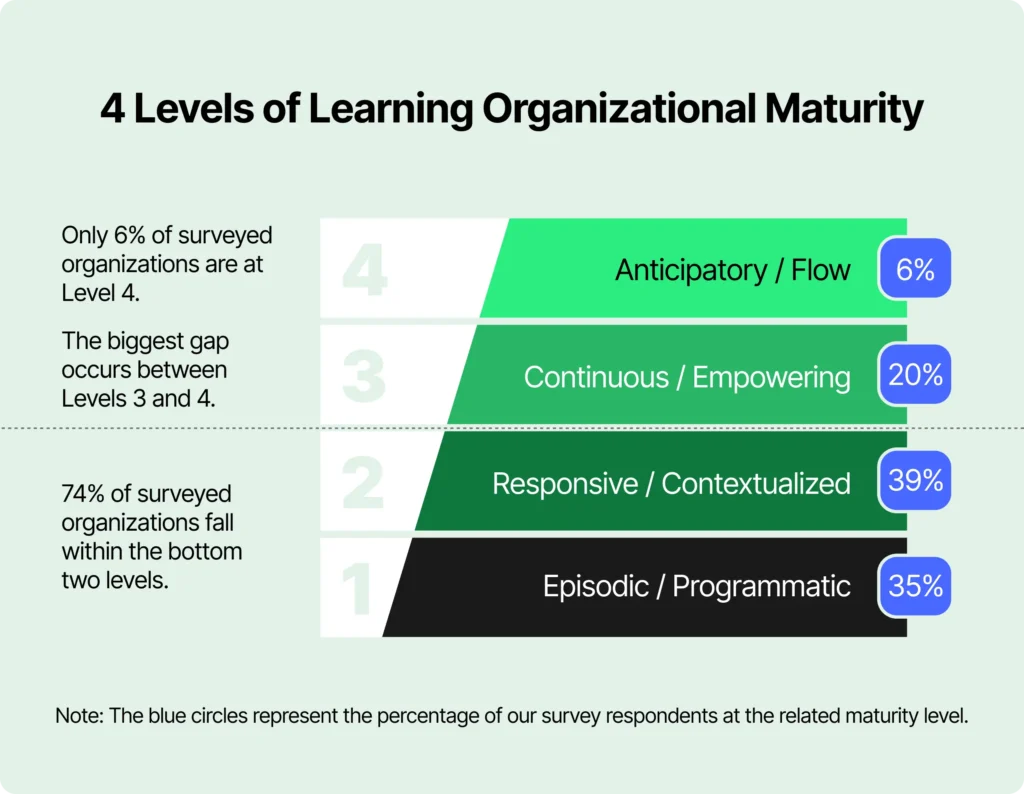- Training
The Evolution Of The Learning Maturity Model

Corporate learning is becoming more than just employee development. When done right, it follows a learning maturity model.
For years, business leaders have been moving beyond basic training best practices to build agile learning organizations that can adapt quickly to changing conditions. This critical business strategy has helped organizations stay competitive and improve their employees’ experiences.
Because becoming a true learning organization doesn’t happen overnight, it’s useful to understand where you are as an organization in your journey toward achieving a level of organizational learning in which work and learning are inseparably intertwined.
The four levels of learning organization maturity
Bersin Research, an independent HR-focused analyst group at Deloitte, has done extensive research on high-impact learning organizations. From its analysis of companies working to build a culture of learning, Bersin has extracted a maturity model that serves as a guide for all organizations looking to evolve to the next level of organizational learning.
According to Bersin’s High-Impact Learning Organization Maturity Model, businesses can fall into one of four distinct levels as a learning organization:
- Level 1: Episodic/Programmatic
- Level 2: Responsive/Contextualized
- Level 3: Continuous/Empowering
- Level 4: Anticipatory/Flow
Bersin’s recent research revealed that 94% of companies fall into one of the first three levels, and only 6% of organizations that have achieved full maturity at level four. With this new Learning Organization Maturity Model, corporate leaders can arm themselves with a framework that allows them to assess their current progress and evolve to the next level of organizational learning.

Source: Bersin – Top Findings From High-Impact Learning Organization Research
Defining the maturity levels
Organizations working to build a seamless culture of learning typically start at Level 1 and reach full maturity at Level 4. For older, less agile organizations, maturity may not be an upward, linear path — some organizations will jump up and down between levels for a multitude of reasons. It’s also important to keep in mind that all parts of the organization may not move at the same speed or take the same path toward maturity.
Ingersoll Rand scales video to drive learning
In this new case study from Bersin by Deloitte, Ingersoll Rand shares how they scale video using Panopto’s industry-leading video platform to enhance many aspects of their global business and operations. Dig into real examples, business results, and more.
While learning organization maturity levels are not absolute, they do give leaders a strong sense for where their companies are at and what they need to do to move forward. Bersin defines the four levels of maturity as follows:
Level 1: Episodic/Programmatic
Companies at this level seek to simply make work more productive through incidental training that is often tactical or reactive.
Level 2: Responsive/Contextualized
At level two, companies are focused on training excellence, led by a centralized Learning and Development (L&D) team responsible for governance and instructional design.
Level 3: Continuous/Empowering
Companies that mature to level three are characterized by their focus on organizational performance, by making talent development a core competency of management throughout the company, and by measuring key performance indicators.
Level 4: Anticipatory/Flow
At the highest level of maturity, a learning organization is characterized by business executives and employees throughout the organization aligned around continuous learning (both formal and informal), aided by the adoption of strategic tools for L&D and an agile corporate structure.
Start working towards building a culture of learning today
While organizational shifts towards becoming a learning organization can take a long time to plan and execute, the tools that support a foundational shift towards a culture of learning can be switched on almost immediately.
A learning management system can be a big help in managing your learning content, but it’s important to consider what kind of content you’ll be keeping there, what kinds of learning materials your employees prefer, and how you’ll go about creating those resources.
Modern LMS tools tend to serve basic content like text and presentation slides well enough, but most struggle to support the technical needs of video production, storage, and streaming. A video platform, then, can be an invaluable tool that allows for easy video content creation as well as content sharing and discovery.



